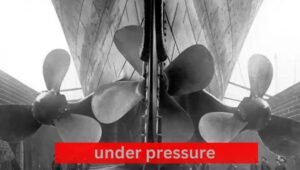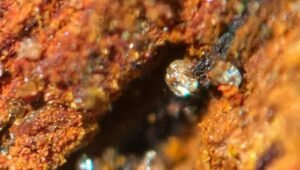Under pressure
The Titanic split into two major sections, the bow and the stern, during its descent to the bottom of the sea, almost 2,000ft 600m apart. While the bow sank slowly, the stern plummeted directly to the ocean floor.
Strewn over a distance of over 1.3 miles 2km from behind the stern to beyond the bow lies a scattering of belongings, fittings, fixtures, coal, and ship parts that fell away as the Titanic sank. Most of the debris is found in clusters around the stern section, a twisted tangle of steel, while the bow has remained mostly intact.
This is because, upon impact with the iceberg, the sheer force of it ripped open rivets off a section of the hull, allowing some 43,000 tons of water to flood into the forward part of the vessel.

Under pressure
Upon breaking free, the after-section was still with compartments filled with air inside. It began to spin towards the seabed; the rapidly increasing water pressure caused the structure around these air pockets to implode, scattering metal, statues, champagne bottles, and passengers’ possessions as it did so.
The bottom of the Titanic resists water pressures of about 40MPa, or about 390 times that on the surface, but since no air pockets remain inside the vessel, the chances of further implosions in this catastrophe are little.
Instead, it is now the weight of the vast ship itself that is playing its role in its demise, as the 52,000 tonnes of steel settle into the ocean floor, creating twisting forces across the steel hull that is pulling the ship apart.
Successive submersible missions have seen the appearance of large cracks and fissures in the steel plates of the hull, while the decking areas have been collapsing inwards.
Devoured by bacteria
Like any iron or steel structure, Titanic is rusting, but under 2.4 miles of seawater, the processes are very different from on land where oxygen and water combine in a chemical reaction that produces iron oxide.
On Titanic, a lot of the corrosion is being done instead by bacteria.
This wreck is smothered in a living, breathing biofilm of bacteria, marine fungi and other microbes that’s literally feeding upon the wreck itself.
Initially, organic materials such as upholstery, pillows, towels and furniture provided a rich supply of nutrients for microbes drifting past in the ocean depths, causing them to settle.

Devoured by bacteria
Like any iron or steel structure, Titanic is rusting, but under 2.4 miles of seawater, the processes are very different from on land where oxygen and water combine in a chemical reaction that produces iron oxide. On Titanic, a lot of the corrosion is being done instead by bacteria.
This wreck is smothered in a living, breathing biofilm of bacteria, marine fungi and other microbes that’s literally feeding upon the wreck itself. Initially, organic materials such as upholstery, pillows, towels and furniture provided a rich supply of nutrients for microbes drifting past in the ocean depths, causing them to settle.